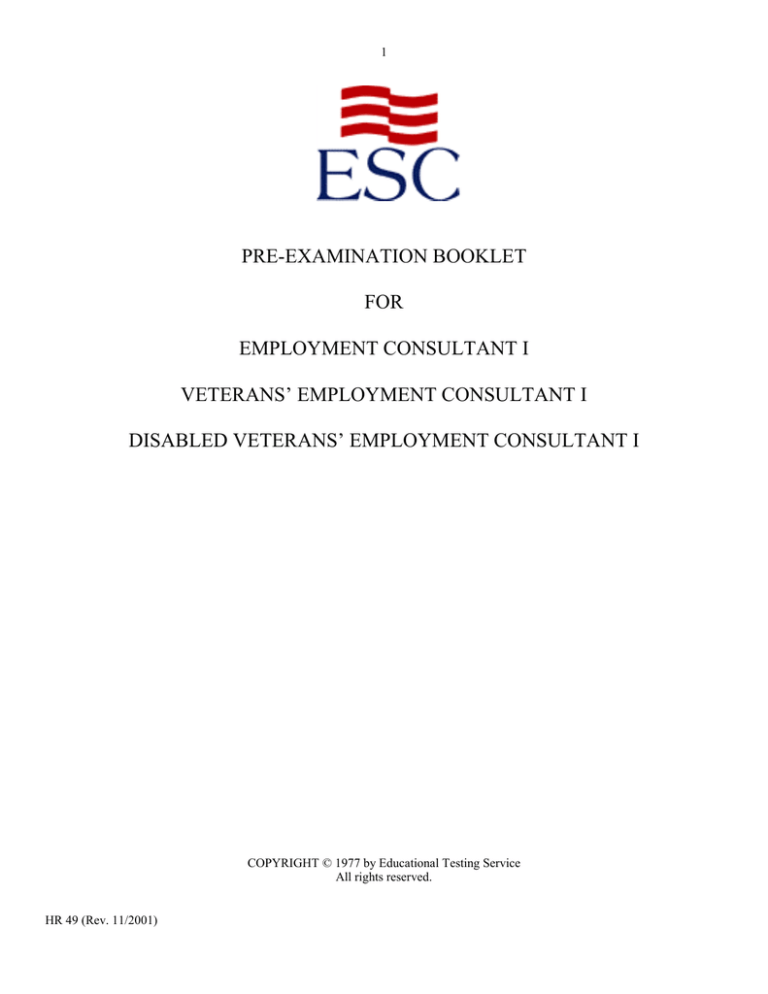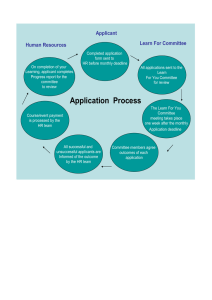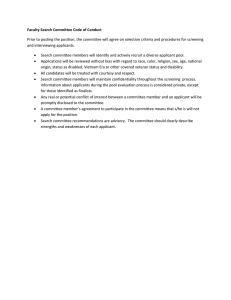
1
PRE-EXAMINATION BOOKLET
FOR
EMPLOYMENT CONSULTANT I
VETERANS’ EMPLOYMENT CONSULTANT I
DISABLED VETERANS’ EMPLOYMENT CONSULTANT I
COPYRIGHT © 1977 by Educational Testing Service
All rights reserved.
HR 49 (Rev. 11/2001)
2
Table of Contents
What the test is about ...................................................................... 1
How to take the test......................................................................... 1
Using the answer sheet.................................................................... 1
Contents of the Test
Verbal Comprehension........................................................ 2
Following Complex Directions ........................................... 3
Induction.............................................................................. 5
Sequential Ordering............................................................. 6
Logical Reasoning............................................................... 7
Problem Sensitivity ............................................................. 8
Coding Operations............................................................... 9
Answers to sample questions ........................................................ 11
Link to a Sample Answer Sheet .................................................... 11
1
What the test is about
The Selection Test for Employment Consultant, Veterans’ Employment Consultant, and
Disabled Veterans’ Employment Consultant is designed for all applicants who want to become
employment consultants in the state employment service. The test is one of several steps
involved in the selection of candidates for employment consultant vacancies. The test is 2 hours
long and consists of 105 multiple-choice questions that measure some of the abilities one needs
in order to be an employment consultant.
In this booklet, different areas of the test will be described and sample questions for each area
will be presented. You may tear out the answer sheet at the end of the booklet and use it to
answer the sample questions. The correct answers to the sample questions can be found on page
11 of this booklet. In order to prepare for this test, the only materials you will need are this
booklet and possibly a dictionary. However, you will NOT be permitted to bring this booklet or
a dictionary to the examination.
How to take the test
When you take the test, you will find that some questions are harder than others, but you should
try to answer every question. If you are not sure of the correct answer, make the best guess you
can and go on to the next problem. Your score on the test will be based on the number of correct
answers. You will not lose any credit for wrong answers or for guessing incorrectly, so it is to
your advantage to answer every question.
Do not spend too much time on any one question. If a question is difficult, mark on the answer
sheet the answer that you think is correct. When you have finished the test, and if you still have
time, you can go back to the difficult question.
Using the answer sheet
When you take the test, you will record your answers on a separate answer sheet rather than
directly in the test book. Because your answer sheet will be scored by machine, it is important
that you make sure you mark each of your answers in the right place. Check frequently to see
that the number next to the answer space is the same as the number of the question you are
answering. The test questions will have four possible choices (1, 2, 3, 4). If you change your
mind about the answer to a question, erase your first answer thoroughly before recording your
new answer.
In using the answer sheet in this booklet, go through the sample questions and mark your
answers on the answer sheet. Then check your answers with the correct answers on page 11. If
you have missed an answer to a question, go back and study the question again.
2
VERBAL COMPREHENSION
The first part of the test is verbal comprehension. This part of the test measures your ability to
understand the meanings of words. Below is a list of words that appear in the test and are often
used by employment consultants in their work. If there are any words you do not know,
carefully look up the words in a dictionary and learn their meanings before the test.
acuity
adhesive
advisability
advocate
aesthetic
algebraic
allergy
amputate
analytic
anthropologist
applicant
architect
archivist
artifact
asbestos
astrology
attendant
availability
awl
bind
botanist
brace
casual
capacity
capitalism
certification
clinical
commerce
compile
compliance
composure
compute
confer
conversant
coordinate
cosmetology
counselor
criteria
curriculum
custody
decoration
depress
designation
determination
deviation
dexterity
diagnosis
digit
discrepancy
doctorate
document
draftsman
drapery
drought
duplication
embezzlement
enhance
equanimity
estate
expectation
expeditious
expel
extensive
extrapolate
fabrication
facility
factor
filler
fluctuate
foreman
fraud
function
gauge
gesture
hierarchy
hue
immobile
impediment
incubation
inflammatory
interfere
inventory
laborer
lawsuit
ledger
liaison
limousine
lucidity
machinist
maintenance
malfunction
manufacturer
masseuse
merchandise
meter
migrant
mortician
motivation
mummify
numeric
oscillate
ophthalmologist
orderly
orthopedic
palsy
paralysis
paramount
perception
personnel
persuade
pertinent
planner
potentiality
preserve
procure
prosecute
province
psychologist
radioactive
ream
recession
recipient
registry
rehabilitation
resignation
resume
retentive
rotary
route
sedentary
selection
sequence
serviceability
sheet metal
solder
spatial
specimen
stamina
stationary
statute
strenuous
supervisor
surroundings
tact
tangible
technician
tender
therapist
touchable
trait
transaction
tutelage
typesetter
vibrate
visualize
voracious
weary
Sample Directions
In each question, choose the word closest in meaning to the word or phrase in capital letters.
Sample Questions
1. STATIONARY:
(1) immobile
(2) similar
(3) slow
(4) regular
2. COSMETOLOGY:
(1)
astrology
(2)
philosophy
(3)
weather prediction
(4)
beauty culture
3. PERCEIVE:
(1) comprehend
(2) handle
(3) collect
(4) worry
3
FOLLOWING COMPLEX DIRECTIONS
This part of the test measures your ability to follow a fairly complex set of directions. Carefully
study the sample set of directions before answering the sample questions.
Sample Directions
In this set of directions, there are four ways to classify applicants for employment: education,
experience, availability, and physical limitations.
EDUCATION - What level of education has the applicant achieved?
A. Completed elementary school
B. Some high school
C. High school graduate
D. Some college
E. College graduate
EXPERIENCE - How much work experience has the applicant had?
A. None
B. 1-2 years
C. 3-5 years
D. 6-10 years
E. 11 or more years
AVAILABILITY - When can the applicant begin work?
A. Immediately
B. 1-2 weeks
C. 3-4 weeks
D. 2-3 months
E. 4-6 months
PHYSICAL LIMITATIONS - What physical limitations does the applicant have?
A. None
B. Wears glasses or has a hearing
problem
C. Suffers loss, impairment, or
paralysis of arm or leg
D. Has allergies
E. Has a heart condition
4
Read each question below and classify the applicant according to the four criteria of education,
experience, availability, and physical limitations. Then assign the applicant to one of the
following four groups. Not all the criteria may be listed in each of the groups below.
Group 1: Applicants belong in this group if they have an A or a B on Education and a C on
Experience. Availability must be an A, B, or C.
Group 2: Applicants belong in this group if they have a C, D, or E on Education and an A on
Experience. Availability must be a B and Physical Limitations an A.
Group 3: Applicants belong in this group if they have a D or E on Education. Experience must
be a D and Physical Limitations a B or C.
Group 4: Applicants belong in this group if they have an A on Education and a B on Experience.
Availability must be a D and Physical Limitations a D.
Sample Questions
For each question below, you are given information about a person looking for a job. First
classify the applicant according to the four criteria given, and then identify the correct group
number and fill in the same numbered space next to the question on the answer sheet.
4. E.R. wants to start her first job in two weeks. She has one year of college and is in excellent
health. In which group does E.R. belong?
5. V.U. has severe arthritis in both arms. He has seven years of experience as an appliance
salesman and two years of college. In which group does V.U. belong?
6. A.I. finished three years of high school and has been working as a seamstress for three years.
She can start a new job in three weeks. In which group does A.I. belong?
5
INDUCTION
The questions on induction in the test measure your ability to reason from specific data or
information to general ideas or hypotheses. The sample questions consist of job titles or brief
descriptions of job activities.
Sample Directions
In each question, three of the job titles or job descriptions are similar or related; the fourth does
not belong with the other three. In each question, choose the one that does NOT belong in the
group.
Sample Questions
7. Which one does NOT belong in this group?
(1)
(2)
(3)
(4)
Stocks a bakery
Stocks a butcher shop
Stocks a shoe store
Stocks a fish market
8. Which one does NOT belong in this group?
(1)
(2)
(3)
(4)
Stage actor
Portrait painter
Television comedian
Nightclub singer
9. Which one does NOT belong in this group?
(1)
(2)
(3)
(4)
Hospital orderly
X-ray technician
Printer
Nurse
6
SEQUENTIAL ORDERING
Sequential Ordering measures your ability to order information in the most meaningful or
appropriate sequence.
Sample Directions
The sample questions consist of three job titles, events, or activities. Based upon the information
provided, choose the best order in which the job titles, events, or activities should appear.
Sample Questions
10. The following jobs represent differences in skill, need for supervision, and amount of
responsibility in a hospital. List them in order from most skill and responsibility required
to least skill and responsibility required.
I.
II.
III.
(1)
(2)
(3)
(4)
Orderly
Nurse
Doctor
I, II, III
I, III, II
III, I, II
III, II, I
11. List the following jobs from most to least amount of daily travel required on the job.
I.
II.
III.
(1)
(2)
(3)
(4)
Building construction laborer
Highway maintenance worker
Assembly-line worker in a factory
I, II, III
II, I, III
II, III, I
III, I, II
12. List the following jobs in order from the one requiring the most finger dexterity to the one
requiring the least finger dexterity.
I.
II.
III.
(1)
(2)
(3)
(4)
I, II, III
II, III, I
III, I, II
III, II, I
Assembler of radio parts in an electronic products company
Order-taking clerk in a sales firm
Bulldozer operator at a sanitation plant
7
LOGICAL REASONING
This part of the test measures your ability to proceed from stated premises to their necessary
conclusions.
Sample Directions
Each question consists of a statement followed by four suggested conclusions. For each
question, choose the best or most logical conclusion that can be drawn from the statement.
Sample Questions
13. “Many crimes occur because people are poor and need food and money.”
(1)
(2)
(3)
(4)
Many crimes are economic in nature.
Most people who are poor should be employed.
Most crime occurs in cities.
Our welfare programs are not adequate.
14. “Unemployment rises during periods of economic recession.”
(1)
(2)
(3)
(4)
Unemployment is caused by international affairs.
Unemployment is affected by the state of the economy.
Unemployment is unpredictable.
Unemployment is necessary in a capitalistic economy.
15. “Hospital patients recover faster in a bright cheerful room than in a gray or poorly lit room.”
(1)
(2)
(3)
(4)
A patient’s surroundings affect his or her recovery time.
Prospective patients should avoid old hospitals.
Patients who have better medical insurance get the nicer rooms.
Some hospitals take better care of their patients than other hospitals do.
8
PROBLEM SENSITIVITY
This part of the test measures your ability to anticipate the implications or consequences of a
given situation. It involves attention to relevant facts and appropriate details that would aid in
the solution to a given problem.
Sample Directions
For each question, choose either the job the applicant would most likely be able to perform
satisfactorily or the job that would be most appropriate given the applicant's background and
personal characteristics.
Sample Questions
16. A twenty-five year old man who recently had one arm amputated and as yet has no
orthopedic replacement.
(1)
(2)
(3)
(4)
Bus driver
Short order cook in a sandwich shop
Waiter
Bridge toll collector
17. A man expressing a preference for working alone.
(1)
(2)
(3)
(4)
Night watchman
Toll collector
Cashier
Tour guide at a park
18. A retired army nurse.
(1)
(2)
(3)
(4)
X-ray technician at a hospital
Doctor’s assistant at a private school
Druggist in a pharmacy
Optician
9
CODING OPERATIONS
This part of the test measures your ability to accurately perform coding tasks.
Sample Directions
Most jobs require a person to work with some combination of Data, People, and Things. The
degree to which a person can be classified within these categories has been arranged below.
Each category is ordered from simple to complex.
Working with Data (paper, records, documents, forms)
0. No significant relationship
1. Recording, compiling, computing, comparing
2. Analyzing, coordination
Working with People
0. No significant relationship
1. Speaking (signaling), persuading
2. Instructing, supervising
Working with Things (tools, machines)
0. No significant relationship
1. Feeding, filling, stuffing
2. Operating, driving
3. Precision working (tests, measures, research)
10
Each question below contains a short job description followed by four possible codes. Of the
four choices given, choose the three-digit code of Data, People, and Things that best reflects the
job description. If there is a choice between two levels of complexity in a given category,
always choose the more complex level.
Sample Questions
19. EGG BREAKER
Separates yolk and white of eggs for use in food products: Strikes eggs against bar, allows
contents to fall into bowl, and throws empty shells into receptacle. Sniffs broken eggs to
detect spoiled ones and dumps spoiled eggs into waste container. Pours broken eggs from
bowl over egg separating device. Pulls lever on machine to retain yolk and to allow white
to fall into cup below.
(1)
(2)
(3)
(4)
Data
0
0
0
1
People
0
1
2
2
Things
1
2
3
1
20. LAYAWAY CLERK
Receives payment on merchandise held in layaway department. Keeps records showing
amount of each payment and computes balance due. Contacts customer when specified
period of time has passed without payment to determine whether customer still desires
merchandise.
(1)
(2)
(3)
(4)
Data
0
1
1
2
People
1
1
2
2
Things
0
0
3
3
21. MASTER MECHANIC
Supervises activities of workers engaged in setting up, installing, repairing, and
maintaining process equipment and machinery, and in fabricating metal parts and tools.
Supervises and helps workers operate and repair parts of equipment and machines.
Supervises workers engaged in dismantling, assembling, and installing industrial
machinery. Fills out orders for spare parts.
(1)
(2)
(3)
(4)
Data
0
0
1
1
People
1
1
0
2
Things
0
1
2
2
11
Answers to Sample Questions
1.
1
11.
2
2.
4
12.
1
3.
1
13.
1
4.
2
14.
2
5.
3
15.
1
6.
1
16.
4
7.
3
17.
1
8.
2
18.
2
9.
3
19.
1
10.
4
20.
2
21.
4
Click Here to View a Sample Answer Sheet


